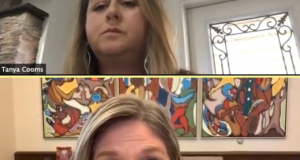Scrapping Ontario’s cap-and-trade program could come with a big price tag, and NDP Leader Andrea Horwath has asked the province’s Financial Accountability Officer (FAO) to look into just how big.
“With Kathleen Wynne and the Liberals’ gas plants scandal, Ontarians saw just how much it costs to rip up contracts,” said Horwath. “Before Mr. Ford rips up the cap-and-trade deal, and makes billions in credits already bought by Ontario businesses worthless, we need to take a hard look at those costs in this case – not just for the province, but the costs to families and businesses.”
So far, $3 billion in emissions credits have been auctioned and bought by businesses. If Ontario leaves the cap-and-trade market, it’s not clear if the province would be on the hook to reimburse those companies, and what other costs and penalties come with ripping up the contracts and agreements Ontario has entered into with Quebec, California and all those industries currently in the cap-and-trade market.
The federal government has committed to impose a carbon tax on any province that doesn’t have its own emissions reduction plan by next year – which also means Ford is risking a federal carbon tax being slapped on Ontario if he scraps cap-and-trade and doesn’t put in any replacement program.
“I believe it’s up to us to leave the next generation with clean air and clean water. I’m worried that not only is Doug Ford jeopardizing Ontario’s environment – he’s asking people and businesses to pay extra to do it,” said Horwath. “Before Ford makes a final decision to scrap cap-and-trade, let’s see just how much that will cost families and businesses – including the impacts on gasoline prices and household heating bills if Ontario defaults to the federally-imposed carbon tax instead of the current cap-and-trade market.”
Peter Weltman, Financial Accountability Officer of Ontario
Financial Accountability Office of Ontario
2 Bloor Street West, Suite 900
Toronto, Ontario M4W 3E2
June 26, 2018
Mr. Weltman;
Premier-designate Doug Ford has said he intends to terminate Ontario’s cap-and-trade system, and break the cap-and-trade agreements and contracts Ontario has entered into.
It’s a critical job of the Legislative Assembly to leave the next generation with a province that has clean air, clean water, and a stable climate. But I am concerned that the decision to scrap cap and trade without a replacement won’t just have serious environmental impacts – it could cost Ontario businesses and the province billions of dollars. For families, scrapping cap-and-trade may mean service cuts and a more expensive life.
With the previous Liberal government’s gas plants scandal, Ontarians saw that ripping up contracts can result in billions of dollars in added costs and penalties. To date, Mr. Ford has not acknowledged the costs, risks or consequences of his actions.
Before the government makes a final decision, the Legislative Assembly and Ontarians deserve a complete picture of how much it will cost to scrap Ontario’s cap-and-trade system. My request to the FAO is to provide an assessment of those costs, taking into account the following questions:
- What are the overall costs, risks and impacts of winding down the cap-and-trade system to the provincial government, households and businesses?
- $2.9 billion in carbon allowances have so far been auctioned, including for future vintages. Is the province financially liable for that money?
- Ontario belongs to a joint carbon market with California and Quebec. Does leaving that market, in apparent contravention of the harmonization agreement with those governments, have costs, liabilities or impacts to Ontario?
- Are there potential litigation costs relating to breaking these contracts and agreements, or leaving businesses with carbon allowance credits that are now worthless?
- What is the potential loss of federal funding for climate change initiatives that was conditional on Ontario’s adoption of a carbon pricing program?
- The federal government will impose a minimum price on carbon starting in 2019. Any province that does not have a carbon pricing system that complies with federal standards will have one imposed by the federal government. This carbon-pricing floor is $20 per tonne as of 2019, rising to $50 per tonne by 2022. If the federal government imposes its own carbon tax to replace Ontario’s cap-and-trade system, what are the comparative impacts to the provincial government, households and businesses over the next five years, including:
- What are the costs to households, businesses and other consumers, including gasoline prices and household heating bills, of a federally-imposed carbon tax, compared to Ontario’s current cap-and-trade system?
- What are the potential litigation costs of a provincial challenge of the federal government’s right to impose a carbon tax?
- Several government programs — including investments in transit, social housing and energy infrastructure — are currently funded by cap-and-trade revenues. What would be the impact of the loss of cap-and-trade revenues on these programs?
- How many Ontario workers are employed as a result of these programs?
- What services, rebates or credits could families and businesses lose as a result of the loss of cap-and-trade funding?
Thank you for your immediate attention to this important matter.
Respectfully,
Andrea Horwath, Leader of Ontario’s Official Opposition
cc: Premier-designate Doug Ford
Bonnie Lysyk, Auditor General of Ontario
Premier-designate Doug Ford
Room 281, Main Legislative Building, Queen’s Park
Toronto, Ontario M7A 1A1
June 26, 2018
Premier-designate Ford;
I’m writing to inform you that I have asked the Financial Accountability Officer of Ontario (FAO) to examine the costs and consequences of terminating Ontario’s cap-and-trade system with no replacement, and breaking the cap-and-trade agreements and contracts Ontario has entered into.
As you’ll recall from the Liberal government’s gas plants scandal, ripping up contracts can result in billions of dollars in added costs and penalties.
I am concerned that the decision to scrap cap and trade without a replacement program won’t just have serious environmental impacts – it could cost Ontario businesses, families, and the province billions of dollars. For families, scrapping cap-and-trade may mean service cuts and a more expensive life.
In short, I don’t believe Ontarians should pay extra to damage the environment.
Your stated goals are to cut spending; and therefore, I’m sure you would agree that it’s critical that we learn how much it will cost the province, and people and businesses in Ontario before you plow ahead with the termination of cap-and-trade. Therefore, I urge you to support my request for an FAO assessment, and cooperate fully with the FAO’s work.
In anticipation of your immediate response, thank you.
Andrea Horwath
Leader of Ontario’s Official Opposition
- Auditor General will investigate Ford’s $1-billion write-off to Hwy 407 company - April 7, 2022
- Horwath’s NDP plans to staff up Northern health care to shorten wait times - March 15, 2022
- Horwath calls on the government to re-start surgeries - January 27, 2022
 Wawa-news.com You can't hear the 'big picture'!
Wawa-news.com You can't hear the 'big picture'!

